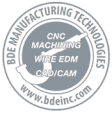Posted On: January 6, 2017
Mold and die makers use a lot of components for effective High Speed Machining (HSM) process. It is now a well-known fact that HSM has strong impact on CNC machine tools, cutting tools, controls, tool holders, and spindles. However, this impact on tool path programming and techniques is often forgotten.
Today, CAD/CAM technology is developing in order to meet the specific requirements for new tool path strategies to suit the HSM environment. HSM is the process of using higher feed rates and spindle speeds for removing material faster without a degradation of part quality. The main focus is to finish mill dies and molds to net shape, in order to improve geometric accuracy, and surface finish so that polishing can be eliminated or at least reduced.
For facilitating high speed machining, following are the requirements for a CAM system:
• It should maximize program processing speed
• It should minimize feed rate losses
• It should maintain a constant chip load
It is essential to note that a number of CAM programs approach the problem, assuming that various specialized tool path strategies may be used to manufacture the part as professionally as possible.
What are the Different Types of Tool Path Strategies? There are different types of tool path strategies that are used to optimize CNC machining services. Here are a few of them:
1. Constant Stepover: A tool path wherein the tool follows the shape of the pocket using parallel paths that are separated by a constant stepover.
Pros:
• Produces a very consistent and regular looking finish.
• This is the simplest tool path strategy. It is a default approach, and may not even be given a name in the CAD program.
2. Constant “Z” Machining: This strategy is particularly used for finishing, where the tool path tracks at a constant Z around the profile that is being machined. It is normally used for steep walls, while in other situations, another strategy is applied. The areas that are not very steep are avoided by limiting the path to contact angles that range from 30 to 90 degrees.
Pros:
• Produces a pretty finish because the scallops are all the same height.
3. Pencil Milling: A final finishing technique primarily intended to address corners and concave areas not handled by tool path strategies used earlier in the program. Pencil milling allows a tool path where the cutter diameter is the same as the diameter of the feature to be milled. Without pencil milling, or rest machining, operators were required to specify the corners that required machining. If you have powerful rest machining, pencil milling is not needed.
Pros:
• Very high surface finish.
• Convenience and productivity
4. Plunge Roughing: A roughing technique where cutting occurs through the motion of only Z-axis much like plunging a drill repeatedly into the work piece. It takes advantage of the fact that most machines are rigid in the Z-axis, and can take a higher feed rate and/or a larger cutter when used in this way. Plunging works best if the tool path is orchestrated to ensure climb milling.
Pros:
• May result in higher performance when roughing.
By implementing dynamic tool path strategies it will not only increase the tool life, surface finish, and spindle life, but also the total cost efficiency and cycle time. You can implement any of the strategies explained above based on your requirement.
Related Blog Post:
Different Types of Dynamic Toolpaths to Optimize CNC Machining Read More
 info@bdeinc.com
info@bdeinc.com 866.262.6233
866.262.6233





